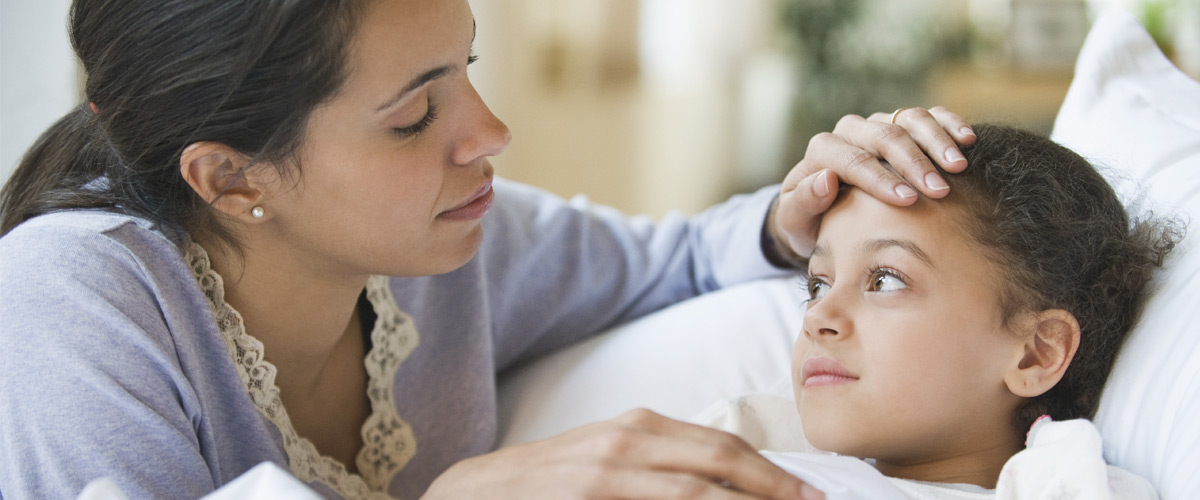Fever in Children: What to Know and When to Worry
A pediatric infectious diseases expert explains how parents can best treat a fever in young kids and when it’s time to seek care.

As many different viruses start circulating this fall, parents and caregivers may begin to worry as soon as they see the first sign of a runny nose or sore throat in their children. Is it RSV? COVID? The flu? But the symptom that usually makes parents most concerned is fever.
“Fever is one of the most common reasons parents call the pediatrician, and when we see an increase in infections, we see more fevers,” said Dr. Karen Acker, a pediatric infectious diseases specialist and hospital epidemiologist at NewYork-Presbyterian Komansky Children’s Hospital and assistant professor of clinical pediatrics at Weill Cornell Medicine.
According to Dr. Acker, a fever, which is defined as a body temperature of more than 100.4° F, is a body’s normal response to fighting an illness. It means the immune system is doing its job, and in most circumstances there is no need to be worried.
Health Matters spoke to Dr. Acker to learn more about fevers, including how long they last, ways to treat them, and when parents need to seek medical care for their children.

Dr. Karen Acker
Health Matters: What are important things a parent should know when their child has a fever?
Dr. Acker: Typically, a fever due to a run-of-the-mill virus can last from 24 hours to three to four days. Sometimes, fevers can last longer — even over a week — and it’s not necessarily a reason to be alarmed, as long as the child is not struggling with other symptoms, such as dehydration, shortness of breath, or severe lethargy or irritability. But if your child has prolonged fever for seven days or more, it is a good idea to bring your child to your pediatrician for evaluation.
It’s a myth that these typical fevers can cause brain damage.
If a child has symptoms such as shortness of breath, fast breathing, poor oral intake of fluids, fever of more than 104° F, then it’s important to see a pediatrician. When babies have difficulty breathing, it’s harder for them to breastfeed or drink from a bottle, and that puts them at risk for becoming dehydrated.
How do you know the fever is due to a common cold, RSV, the flu, or COVID-19?
These viruses can often look alike, and while there are some general differences, the only way to know for sure is to bring your child to the pediatrician to get tested. Influenza is typically accompanied by high fever (103° or 104° F), body aches, fatigue, and upper respiratory symptoms, including cough. RSV usually causes runny nose and cough, but children can get a fever, and 20% to 30% of children have faster breathing due to infection of the lower airways (known as bronchiolitis). COVID-19 can cause runny nose, cough, and fever, but it appears to be a less common cause of more severe disease and hospitalization in children compared to RSV and influenza.
To protect your child from RSV, influenza, and COVID-19, safe and effective vaccines are now available for all three viruses. Reach out to your pediatrician to find out which vaccines are available for your child. The ideal time to get vaccinated is early fall, so your child will be covered by the time the viruses start to circulate.
When is it time to take your child to the emergency department?
That’s always the big question.
For infants less than 6 weeks old, a fever always warrants a visit to the emergency department, because young babies are at higher risk for infection. You can call your pediatrician and they will recommend going to the emergency room.
For older infants, you should discuss with your pediatrician. The pediatrician should always have an on-call service.
If your child is unable to drink, is dehydrated (has less than five wet diapers in 24 hours), has difficulty breathing, or if your baby is inconsolable, it is recommended to go to the emergency department.
How can parents treat fevers at home?
Treating a fever is more about treating the symptoms rather than trying to bring down the temperature.
If a child has a fever and is still playing, drinking fluid, eating, and running around, there is no need to treat it with medication.
However, it’s normal for children to feel really uncomfortable when they have a fever. Typical symptoms include feeling achy, having chills, or a headache. Over-the-counter fever reducers, such as acetaminophen (Tylenol) and ibuprofen (Advil, Motrin), can reduce a child’s temperature and help them feel better.
Remember, babies under 6 months cannot take ibuprofen – only acetaminophen.
You don’t need to give your child a cold bath (unless it makes your child feel better).
Many people believe an ice-cold bath is the answer to a fever. The truth is, that will only make your child really upset, and after the bath, the fever will go right back up again. If your child wants to take a bath, lukewarm water does gently reduce the body heat.
Can you explain what causes a febrile seizure?
We are still learning why a fever can trigger seizure activity in the brain and why certain children have febrile seizures, although it is likely due to a mix of genetic and environmental factors. For parents, it is really scary to witness, but fortunately febrile seizures are almost always benign. If your child has a seizure at the same time as a fever, you should go to the emergency room for evaluation to make sure it is a simple febrile seizure. If it is just one isolated seizure that lasts less than 15 minutes (simple febrile seizure), it will likely have no lasting effects on the brain, and it will not increase the risk for epilepsy. If there is more than one seizure in a 24-hour period or a prolonged seizure, your child may be observed for longer and be evaluated by a neurologist.
Does a fever mean a child is contagious?
Usually children with viral infections are the most contagious when they have a fever. That’s why schools have specific guidelines about kids needing to be fever-free, without medication, for a full 24 hours before returning to the classroom.
What foods or drinks are recommended when a child has a virus?
The main priority is good hydration, so make sure your child is drinking plenty of fluids. When children have a fever, they usually don’t hydrate as well. I tell parents to monitor how much the child is urinating. It’s easy with a baby because you can check the diapers, and you want at least five wet diapers in a 24-hour period. For older kids, urinating every six hours is normal.
They are probably not going to have a big appetite, and that’s OK. If your child has vomiting and diarrhea, it’s best to choose foods that are not too hard on the stomach, such as applesauce, rice, and toast. And, of course, chicken soup, which has the added benefit of helping with hydration. Parents also ask about vitamin C or zinc to fight infection. If your child has a balanced diet, they are getting the appropriate amounts of vitamin C and zinc, so supplementation is not generally recommended or thought to have any impact.
